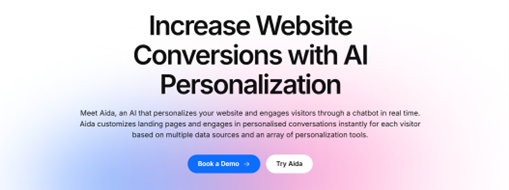Part 1 In The Series “Mastering Modern Business Success: Key Strategies for Sustainable Growth and Competitiveness“
The pace of change in the modern business world is astonishing. Digital transformation for small businesses has become a vital strategy for those who want to thrive in 2025 and beyond. Technology isn’t just an accessory anymore—it’s the backbone of growth, efficiency, and innovation. Yet, many entrepreneurs and business owners are left wondering how to embrace this shift without feeling overwhelmed. In this article, I’ll explore how integrating technology into your business can unlock new opportunities and set you apart from the competition.
Disclosure: If you click on my affiliate/advertiser’s links, I am going to receive a tiny commission. AND… Most of the time, you will receive an offer of some kind. It’ s a Win/Win!
Embracing digital transformation means more than just upgrading your tools—it’s about creating a cohesive strategy to align your operations, processes, and customer experiences with the demands of the digital age. Whether it’s leveraging business technology integration or tapping into the power of AI for business growth, the benefits are undeniable. But understanding where to start and which steps to take is often the hardest part.
I’ve spent countless hours researching, experimenting, and learning about the transformative potential of technology. I know what it’s like to feel stuck in outdated systems, unsure of how to bridge the gap between traditional methods and modern tools. This article is for people like you and me—those who want to lead their businesses with confidence and foresight.
Throughout this piece, I’ll break down the essentials of digital transformation in plain English. Together, we’ll uncover why it’s crucial to integrate advanced tools like automation and analytics into your workflow. I’ll also share practical steps you can take to ensure a seamless transition that enhances productivity without disrupting your team’s dynamics.
So, whether you’re looking to improve efficiency, deliver better customer experiences, or future-proof your operations, this guide is your starting point. Let’s dive into how digital transformation can revolutionise your business processes in 2025, and why this journey is one you cannot afford to miss.
Table of Contents
1. What Is Digital Transformation?
Discover the true meaning of digital transformation and why it’s more than just a buzzword in 2024.
2. Why Digital Transformation Matters for Small Businesses
Learn why businesses of all sizes must embrace digital tools to remain competitive in today’s market.
3. The Role of AI and Machine Learning in Business Growth
Explore how artificial intelligence and machine learning can streamline operations and boost decision-making.
4. How to Start Your Digital Transformation Journey
A step-by-step guide to integrating digital tools without overwhelming your team or budget.
5. The Power of Business Technology Integration
Understand how combining the right tools can create a seamless and efficient workflow.
6. Overcoming Challenges in Digital Transformation
Address common obstacles businesses face when adopting new technologies and how to tackle them.
7. Real-Life Examples of Digital Transformation Success
Be inspired by case studies of businesses that achieved growth and innovation through digital strategies.
8. How Digital Transformation Enhances Customer Experience
Learn how technology can help you deliver personalised, efficient, and memorable interactions with your clients.
9. The Future of Digital Tools in Small Business Operations
Get insights into emerging trends and technologies that are shaping the future of business.
10. Your Next Steps in Embracing Digital Transformation
Practical tips to keep your business ahead of the curve and fully prepared for 2025 and beyond.
11. Summary & Conclusion: Embracing the Future of Your Business: The Time to Act Is Now!
1. What Is Digital Transformation?
Digital transformation is about integrating digital technologies into all areas of a business, leading to fundamental changes in how you operate and deliver value to customers. It’s a strategic move, not just a technological upgrade, and it’s become a necessity for businesses aiming to stay competitive.
For example, instead of manually processing orders, a retailer could adopt an integrated e-commerce platform that automates inventory updates, customer communication, and shipping logistics. This doesn’t just improve efficiency; it enhances the customer experience and reduces operational errors.
The essence of digital transformation strategy is aligning technology with your business goals. For instance, if your priority is improving customer service, adopting a chatbot powered by artificial intelligence (AI) could streamline response times and availability. However, without a clear strategy, you risk adopting technology that doesn’t address your real needs.
Actionable Advice: Start by auditing your current processes. Identify inefficiencies and areas where technology could make a measurable impact. Consider both short-term improvements and long-term scalability when selecting tools.
2. Why Digital Transformation Matters for Small Businesses
For small businesses, digital transformation is often the difference between growth and stagnation. While large companies have the resources to invest in cutting-edge technology, small businesses can adopt agile strategies to level the playing field.
Take, for instance, a small café that uses a cloud-based point-of-sale (POS) system to track sales, manage inventory, and offer loyalty rewards. This not only improves efficiency but also provides valuable insights into customer behaviour, which can be used to drive targeted marketing efforts.
The risks of ignoring digital transformation are significant. Without adopting modern tools, small businesses may struggle to meet customer expectations or compete with larger, more agile competitors. Whether it’s cloud solutions, e-commerce platforms (such as Shopify), or automation tools, small business technology adoption is no longer optional—it’s essential.
Actionable Advice: Start small. Adopt tools that solve immediate problems, such as accounting software to simplify bookkeeping or email marketing platforms to improve outreach. Gradually expand your digital toolkit as your needs evolve.
3. The Role of AI and Machine Learning in Business Growth
AI and machine learning are game-changers for businesses. These technologies can automate repetitive tasks, analyse vast amounts of data, and predict trends with remarkable accuracy. By leveraging AI, businesses can make data-driven decisions that are both faster and more effective.
For example, an online retailer can use AI algorithms to recommend products based on customer behaviour. This not only increases sales but also enhances the shopping experience by offering personalised suggestions. Similarly, machine learning can be used in supply chain management to predict demand and optimise inventory levels.
The danger of ignoring AI is becoming obsolete in an increasingly competitive market. Businesses that fail to adopt these technologies may find themselves outperformed by competitors who use AI to innovate and operate more efficiently.
Actionable Advice: Begin by identifying tasks that consume a lot of time but don’t necessarily require human expertise, such as data entry or customer inquiries. Implement AI-powered tools like chatbots or analytics platforms to automate these processes.
4. How to Start Your Digital Transformation Journey
Starting your digital transformation journey can be daunting, but breaking it down into manageable steps makes the process more achievable. The first step is to identify areas where digital tools can address existing challenges or inefficiencies.
For instance, if you’re still managing schedules manually, consider adopting an online scheduling tool. If customer communication is a bottleneck, explore CRM software that automates follow-ups and provides valuable insights into customer interactions.
It’s equally important to set clear goals. Are you looking to increase sales, improve efficiency, or enhance customer satisfaction? Your goals will guide your decisions and help you measure the success of your efforts.
Actionable Advice: Begin with a pilot project. Choose one area of your business to digitise and measure the results. Use the insights gained to refine your approach before scaling up.
5. The Power of Business Technology Integration
Technology integration is about creating a seamless ecosystem where tools work together to optimise processes. When systems are disconnected, inefficiencies arise, leading to wasted time and resources. Successful integration ensures that data flows smoothly across platforms, enabling better decision-making.
For example, an e-commerce business that integrates its website with inventory management and accounting software can automatically update stock levels, generate invoices, and track financial performance—all without manual intervention. Shopify, for instance, takes care of everything from marketing and payments to secure transactions and shipping.
Neglecting integration can result in duplicated efforts, errors, and frustrated employees. It’s not just about adopting tools; it’s about ensuring they work together harmoniously to achieve your business objectives.
Integrating financial tools into your digital ecosystem is vital. Quicken, for instance, allows you to automate invoicing, track expenses in real-time, and generate detailed reports—all of which can save hours of manual work and improve accuracy.
Actionable Advice: When selecting software, prioritise tools with integration capabilities. Many platforms offer APIs or built-in integrations with popular tools. This ensures scalability and compatibility as your business grows.
Stop guessing, start growing: Unlock actionable Shopify insights with Sirge and get 20% Off.
6. Overcoming Challenges in Digital Transformation
Digital transformation comes with its fair share of challenges. Common obstacles include employee resistance, budget constraints, and a lack of technical expertise. Overcoming these challenges requires careful planning and communication.
For example, employees may resist change if they feel it threatens their roles. Providing training and involving them in the decision-making process can help ease this transition. Similarly, budget constraints can be addressed by prioritising investments with a clear ROI, such as tools that save time or reduce costs.
Actionable Advice: Create a change management plan that addresses potential challenges. Communicate the benefits of digital transformation to your team and ensure they have the resources and training to adapt.
Edureka Big Offers – Unlock Savings with AMEX Bank Card7. Real-Life Examples of Digital Transformation Success
Many businesses have successfully implemented digital transformation strategies, and their stories provide valuable lessons. One such example is Domino’s Pizza, which embraced digital tools to enhance its customer experience. By adopting an app that allowed users to order, track deliveries, and provide feedback, Domino’s significantly increased its sales and customer satisfaction.
Another example is a small bakery in the UK that transitioned to an online ordering system during the pandemic. This move not only kept the business afloat but also expanded its customer base beyond the local community.
These success stories highlight the transformative potential of digital tools when implemented thoughtfully. They also emphasise the importance of aligning technology with customer needs.
8. How Digital Transformation Enhances Customer Experience
Digital tools enable businesses to deliver personalised, efficient, and consistent customer experiences. From AI-powered chatbots to CRM systems, technology can help you understand your customers better and meet their expectations.
For instance, a subscription box company might use CRM software to analyse customer preferences and offer tailored product recommendations. This not only boosts customer loyalty but also increases revenue.
Neglecting digital tools can lead to outdated, impersonal interactions that drive customers away. Investing in tools that enhance the customer experience is a strategic move that pays off in the long term.
Actionable Advice: Use customer feedback to identify pain points in your service. Implement tools that directly address these issues, such as live chat software or loyalty programmes.

9. The Future of Digital Tools in Small Business Operations
Emerging technologies like blockchain, IoT, and advanced analytics are shaping the future of business. While these may seem out of reach for small businesses now, staying informed ensures you’re prepared to adopt them when the time is right.
For example, blockchain can improve transparency and security in supply chains, while IoT devices can optimise energy usage in physical stores. These tools represent the next frontier of business innovation strategies.
Actionable Advice: Keep an eye on industry trends and consider how they might apply to your business. Start small by experimenting with new technologies in low-risk areas.
10. Your Next Steps in Embracing Digital Transformation
Digital transformation is an ongoing journey. Begin with small, strategic changes, such as automating repetitive tasks or adopting a cloud-based solution. Evaluate your progress regularly and adapt as needed.
The most important step is to start! The longer you wait, the more ground you lose to competitors who are already leveraging these tools.
Actionable Advice: Develop a roadmap for your digital transformation journey. Set clear milestones and celebrate small wins to maintain momentum.
11. Summary & Conclusion: Embracing the Future of Your Business: The Time to Act Is Now!
Digital transformation is no longer just an advantage—it’s a necessity. As we’ve explored, integrating modern technology into your business processes can revolutionise how you operate, compete, and deliver value to your customers. From understanding the essence of digital transformation strategy to leveraging AI, integrating tools, and enhancing customer experiences, each aspect we discussed offers a critical pathway to growth and resilience.
By now, you’ve seen how even small businesses, like a café adopting cloud-based POS systems or a bakery implementing online orders, can harness technology to thrive. These aren’t isolated cases—they’re proof that with the right approach, businesses of all sizes can transform challenges into opportunities. Whether it’s improving efficiency, reducing costs, or staying competitive, digital transformation provides practical solutions for today’s most pressing business needs.
However, transformation is not a one-time event. It’s an ongoing journey that requires consistent evaluation, adaptation, and commitment. The road may have challenges, as we’ve discussed, but every step forward brings you closer to a more agile, competitive, and customer-focused business. The key takeaway here is that you don’t have to do it all at once. Start small, identify key pain points, and implement tools that address them. The rest will follow.
As someone who’s deeply invested in understanding what makes businesses succeed, I know the doubts and hurdles that come with adopting new ways of working. It’s tempting to stick to what you know, but the risk of stagnation is far greater than the effort required to adapt. The world is moving forward—your business deserves to move with it.
I encourage you to revisit the points discussed in this article and think about how they apply to your own business. What inefficiencies could you address? How could technology help you connect more deeply with your customers? What steps can you take today to prepare for the future? These aren’t just hypothetical questions—they’re the starting points for action.
At Krislai.com, my goal is to empower you with the knowledge and strategies to elevate your business acumen and leadership skills. This article is just the beginning. The upcoming articles in this series will look even deeper into areas like operational efficiency, ESG strategies, and workforce transformation, providing actionable insights that you can implement right away.
So, stay tuned. Bookmark this blog, sign up for updates, and make it a point to return regularly. Together, we’ll continue exploring the tools, strategies, and mindsets that will keep your business not just surviving, but thriving in the years to come. Let’s embrace this journey of growth and innovation, and transform your vision into reality. The future of your business starts here.
- Turn AI Anxiety into Competitive Advantage: How to Future-Proof Your Workforce for the AI Revolution
- Unlock Profit: Calculate Customer Lifetime Value & Maximize Growth
- Creating a Customer Persona: A Step-by-Step Guide On How To Do It
- Unleashing the Power of Digital Signage: The Best Software to Transform Your Business
- How Businesses Can Use Freelance Platforms & Expert Networks to Scale Smarter








